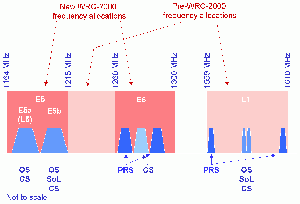If you wish to contribute or participate in the discussions about articles you are invited to contact the Editor
Galileo Integrity Monitoring
| GALILEO | |
|---|---|
| Title | Galileo Integrity Monitoring |
| Author(s) | ESA |
| Level | Basic |
| Year of Publication | 2010 |
Description
The GALILEO System will be an independent, global, European-controlled, satellite-based navigation system and will provide a number of guaranteed services to users equipped with Galileo-compatible receivers. One of these services is the GALILEO Safety-of-Life Service (SoL) which improves the open service performance through the provision of timely warnings to the user when it fails to meet certain margins of accuracy (integrity).
Purpose
The target markets of the Safety of Life service are safety critical users whose applications or operations require stringent performance levels such as running trains, guiding cars, navigation and aviation. Galileo will provide to its users not only a global positioning service (Open Service), but also the associated integrity information for SoL services. This is an important contribution of Galileo against the GPS or GLONASS systems, where the SoL integrity must be provided by augmentation systems (WAAS, EGNOS...).
Performance and features
In comparison with other regional services (WASS, EGNOS…) provided by traditional ground infrastructures, Galileo SoL Service will provide integrity information at global level. A worldwide seamless service will increase the efficiency of companies operating in a global basis, e.g. airlines, transoceanic maritime companies.
The Safety of Life service will provide two levels to cover two conditions of risk exposure:
- The Critical level covers time critical operations for example, in the aviation domain approach operations with vertical guidance.
- The Non-Critical level covers extended operations that are less time critical, such as open sea navigation in the maritime domain
The critical level will be obtained by using certified dual-frequency receivers in the following frequencies:
- E5b and L1.
- E5a, E5b and L1
Whereas Non-Critical level will be possible to obtain by using monofrequency receivers in the bands E5b or L1.
According to Galileo Requirements Document the SoL multi frequency service in the critical level shall provide:
- Horizontal Accuracy <= 220 m (NSE- 95%)
- Integrity Risk <= 10-7 per hour
- Mean Availability over the operational life of at least 99.5 % for integrity and 99.8 % for accuracy for any location within the default service volume. (HAL 12m, VAL 20m)
With regard to the non critical level it will be also possible to obtain by using mono frequcency receivers in the band: E5b or L1. According to Galileo Requirements Document the SoL multi frequency and mono frequency service in the critical level shall provide:
- Horizontal Accuracy <= 4 m (NSE- 95%) and a Vertical Accuracy <= 8 m (NSE - 95%).
- Integrity Risk <= 3.5.10-7 per period of 150s
- Mean Availability over the operational life of at least 99.5 % for integrity and 99.8 % for accuracy for any location within the default service volume. (HAL 556m) TBC
The performance objectives in terms of position accuracy, availability and integrity are described in the following table
| Galileo Open Service (positioning & timing) | ||
|---|---|---|
| Single Frequency (SF) | Dual Frequency (DF) | |
| Coverage | Global | |
| Accuracy (95%) | Horizontal: 15 m | Horizontal: 4m |
| Vertical: 35 m | Vertical: 8m | |
| Availability | 99.8 % | |
| Timing Accuracy wrt UTC/TAI | N/A | 30 ns |
| Ionospheric Correction | Based on SF Model | Based on DF Measurements |
| Integrity | No | |
To know more information about Performances of each Galileo Service see the article Galileo Performances.
Implementation
The Open Service signals are separated in frequency to permit the correction of errors induced by ionospheric effects by differentiation of the ranging measurements made at each frequency. Each navigation frequency will include two ranging code signals (in-phase and quadrature). Data are added to one of the ranging codes while the other “pilot” ranging code is data-less for more precise and robust navigation measurements.
During the Initial Operational Capability (IOC) phase, the GALILEO open service, the search and rescue service and the PRS will be provided. At this stage, however, accuracy and availability will not yet have reached their optimum levels.[1]

